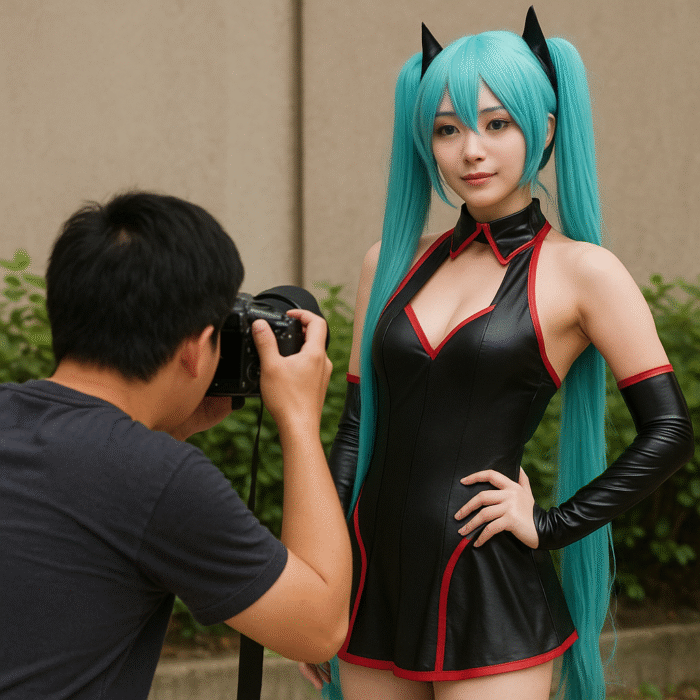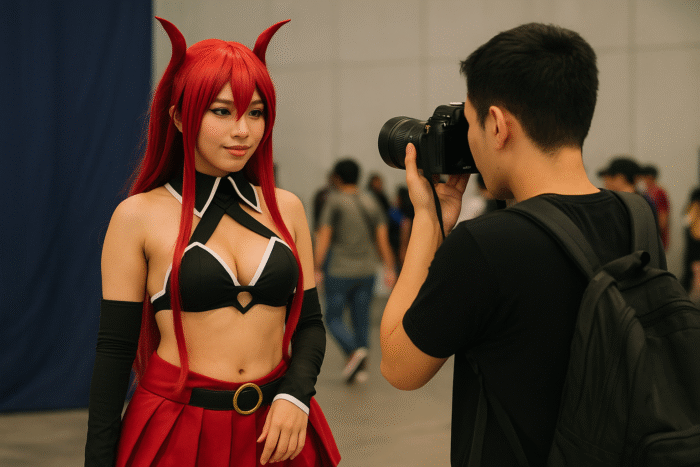Cosplay Community has its own dark sides.
Cover photo or featured image was generated by AI. For illustration purposes of this post.
Sexual harassment in the Cosplay community in the Philippines is a serious and recurring issue, often rooted in objectification, lack of awareness about consent, and weak enforcement of protective policies at events. While the community can be a positive space for creativity and expression, sexual harassment has caused many Cosplayers, particularly women and LGBTQ+ individuals, to feel unsafe, uncomfortable, or even leave the scene entirely.
Key Forms of Sexual Harassment in the Philippine Cosplay Scene

- Non-Consensual Photography and Voyeurism
- Mostly, the victims of this will be always women and other LGBTQ+ individuals. Cosplayers wearing costumes and outfits, which are somewhat revealing, can be the victims of sexual harassment by suspecting photographers, who are taking pictures at unusual angles without permission. The term, known as “creepshots”, is basically taking photos at lower and/or unusual angles, aiming at a Cosplayer’s exposed, bare body parts. And at the end of the day, until next day, these suspecting photographers post or manipulate these photos, and uploading them without credit or consent from the Cosplayers.
- In most of my Cosplay photography contents, known to be mobile or camera photography, I always credit or attribute a Cosplayer (I always ask for their name in their social media accounts available), and I put their name on the description of my photo, along with my name watermark in it.
- Most of the time, after I photographed a Cosplayer, I always show to him/her my photo outputs.
- Mostly, the victims of this will be always women and other LGBTQ+ individuals. Cosplayers wearing costumes and outfits, which are somewhat revealing, can be the victims of sexual harassment by suspecting photographers, who are taking pictures at unusual angles without permission. The term, known as “creepshots”, is basically taking photos at lower and/or unusual angles, aiming at a Cosplayer’s exposed, bare body parts. And at the end of the day, until next day, these suspecting photographers post or manipulate these photos, and uploading them without credit or consent from the Cosplayers.
- Inappropriate Touching and Physical Proximity
- Some con-goers tend to do some weird stuff, aside from taking photos/selfies from Cosplayers while in the middle of the walking crowd. Weird stuff like touching the Cosplayer in her sensitive parts, her wig, or even doing “fanservices” without permission or consent while taking photos or selfies.
- Unless a Cosplayer gave you a consent to do those stuff in your liking, don’t really do it. If they said “no”, it means no, and don’t even force yourself in.
- In my experience, it is very rare to run with some female Cosplayers offering a “free hug”. So then, it’s safe to hug them, and remember to always thank them because they allowed you to do it with them!
- Unless if you were close friends, you can safely hug that Cosplayer when you are leaving from an Anime convention to say goodbye! But always remember: Always ask permission and consent first!
- Some con-goers tend to do some weird stuff, aside from taking photos/selfies from Cosplayers while in the middle of the walking crowd. Weird stuff like touching the Cosplayer in her sensitive parts, her wig, or even doing “fanservices” without permission or consent while taking photos or selfies.
- Verbal Harassment and Catcalling (Usually on Social Media)
- Catcalling, lewd comments, and unsolicited sexual remarks are common, especially for female-presenting or gender-bending cosplayers.
- Harassers may attempt to justify their behavior by claiming the costume is “provocative.”
- Harassment by Fellow Cosplayers or Photographers
- Sometimes, sexual harassment in Cosplay community does not always come from outsiders (or the term “normies”). Some people, including photographers, or even an another Cosplayer, can be also one of the offenders.
- Especially when it involves some famous Cosplayers and photographers, the case for victims to speak up can be hard and difficult to solve.
Online Sexual Harassment
- Usually, these can continue online through with inappropriate DMs (direct messages) and post comments. Such comments and messages, like body shaming, sending some unsolicited sexual content and pictures (i.e. send nudes, etc.), and even sending some AI-generated explicit photos, are some examples. Sometimes, sex offenders tend to stole some Cosplayer’s photos, and then reposting it in some adult and/or fetish websites. Or even using their photos to generate explicit content using AI.
In Anime and Cosplay Conventions, it still persists.
- Some Anime conventions and events may lack security, anti-harassment policies, or even their reporting systems.
- That’s why Anime conventions has implemented their stricter Cosplayer-Attendee Interaction Etiquette. That once a con-goer has violated a rule, he or she is in a risk of getting banned for several months, up to even a year. Example would be Cosplay Mania.
- Some offenders are tending to “pretend” that they are victims, telling that the real victims are often told they “asked for it” due to the way they dressed or posed.
- Conservative societal norms view Cosplay (especially sexy costumes) as “immoral”, leading to double standards in how victims are treated — a cultural conservatism and sexism.
- Some victims may be afraid to speak out due to fear of backlash or retaliation, being ostracized, or damaging their reputation.
- Sexual harassment still persists due to the lack of legal action — slow pace of legal process.
If You’re a Victim or a Witness of Sexual Harassment-Related Incidents in the Cosplay Community:
- Speak up if it’s safe—say clearly that behavior is not okay.
- Report the incident to event organizers or security immediately.
- Document everything: Take photos, videos, or screenshots when possible.
- Seek support: Talk to trusted friends, support groups, or legal professionals.

